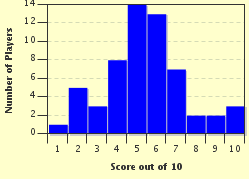Quiz Answer Key and Fun Facts
1. Magnetic compasses point to the north magnetic pole, but on most maps, "north" points to the geographic pole. What is the term for the angular difference between the magnetic and geographic pole at a particular spot on the Earth?
2. When using a magnetic compass, you should take care to keep it away from ferrous metal objects or electrical devices that produce a magnetic field. What is the term for the error caused by local magnetic fields acting on a compass?
3. An orienteering compass has a (usually) rectangular base surrounding the compass itself. While the compass needle points to magnetic north, what is the large fixed arrow printed on the base of the compass called, the one you point towards your destination to get a bearing or keep on track?
4. What units are compass courses measured in, that are marked around the circumference of the compass dial?
5. To keep your orienteering compass handy for frequent measurements while walking or running, what is the most common way to attach the compass to yourself?
6. A special kind of map is used in orienteering, one that represents the three-dimensional earth surface on a two-dimensional piece of paper. What is this type of map?
7. Most maps use the traditional latitude and longitude to define locations on the map. Some maps, used for orienteering and other purposes, use another coordinate system abbreviated as UTM. What does UTM stand for?
8. What is the procedure used to find your location by taking and plotting compass bearings to prominent objects marked on a topographic map? This word can also mean a surgical procedure.
9. Which U.S. government agency produces the land maps used in orienteering?
10. How do you measure distance traveled when orienteering, while walking or running the course?
Source: Author
wjames
This quiz was reviewed by FunTrivia editor
WesleyCrusher before going online.
Any errors found in FunTrivia content are routinely corrected through our feedback system.


